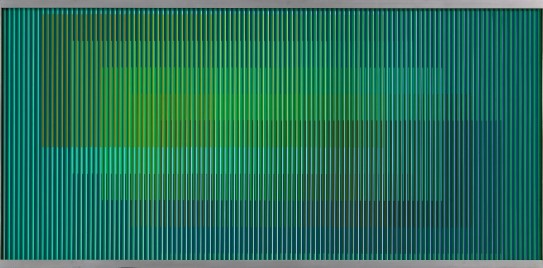Physichromie no. 673
Carlos Cruz-Diez
Transcription
Narrator:
Any work of art can make us feel a sense of wonder. A bit like when a seven-year-old thinks aloud about colours.
Child:
In a way, all colours speak and tell us stuff: orange is rather calm, and yellow is kind of happy. And green is like: yes! Finally, yes! Yes! Kind of. Um, it’s a bit difficult to explain.
Narrator:
In this work, it is precisely these green, thin strips of plastic that filter and reflect the light in different ways, depending on where you are standing. When you move around and change your viewpoint, that’s when the artwork really emerges. The colours change, new patterns emerge, it’s almost as though something magical happens.
Child:
Mmm. It’s pretty amazing that it’s possible. But in a way, it looks a bit like a stripy TV. With a frame around it.
Narrator:
The artist behind “Physichromie no. 673” wanted to make people feel a sense of wonder. “Art teaches us to see, listen and discover. Art *teaches us wonder,” he said.
Child:
So he was actually pretty clever, because it’s a good idea to be curious.
But what was he called?
Narrator:
Carlos Cruz-Diez.
Child:
What country did he come from?
Narrator:
Venezuela.
Child:
Oh, I haven’t heard of that before.
Narrator:
The playful artworks of Carlos Cruz-Diez are light catchers, created to take us viewers into another world, a world of colours, sensations and wonders.
You can play your own game with light and colour filters in Room 80, here at the museum.